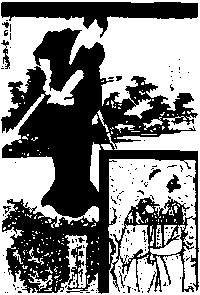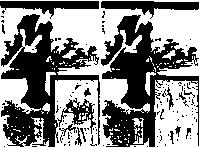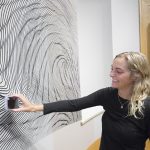
There are many bizarre and wildly gruesome prints on view in the current Bowdoin College Museum of Art exhibition Fantastic Stories: The Supernatural in Nineteenth-century Japan. Sarah Montross, Andrew W. Mellon Post-Doctoral Curatorial Fellow, shares her thoughts on one of the prints.
While the print may not initially be the most visually striking, it is quite unique. Titled The Ghosts of O-Iwa and Kohei, Nailed to a Board (ca. 1847-1851), this print is among several that show scenes from one of the most famous kabuki plays, Yotsuya Kaidan (“A Creepy Tale from Yotsuya”), written in 1825 by Tsuruya Namboku IV. In this play, a masterless samurai Tamiya Iemon devises a treacherous plot to poison his wife, O-Iwa. She becomes horribly deformed from the poison, and thus Iemon has grounds to divorce her and marry a new wife of higher social standing. O-Iwa eventually dies and, in the same act, Iemon murders his neighbor Kohei and later nails their bodies to a door and disposes of them in a nearby river. The vengeful O-Iwa soon returns to haunt Iemon. This print depicts the murderer along the riverbank, horrified by the ghosts of his wife and neighbor.

Because this print is now framed, visitors may not initially realize that it is an interactive print. There is a small flap on the bottom right corner: one side of the flap shows O-Iwa and the other shows Kohei, each emerging from the dark riverbed, nailed to the door.
In 19th-century Japan, woodblock prints and kabuki were intimately linked, as publishers appealed to a growing merchant class who had a taste for violent and fantastic spectacles in print and on stage. This print not only depicts a scene from the kabuki narrative but also mimics the stage technique of toita-gaeshi (flipping the door) where the same actor would have appeared as separate characters on opposite sides of a wooden door.
In the 20th century Yotsuya Kaidan was transformed into several films. Clips from one of the finest adaptations are currently playing in the Museum’s Media Gallery (1959, directed by Nobuo Nakagawa). One of the scenes on view is this same haunting moment by the canal. Visitors can thus understand how these narratives moved fluidly from the kabuki stage to the printed image and, eventually, to the medium of film. Each adaptation is equally artful, entertaining and instructive.
